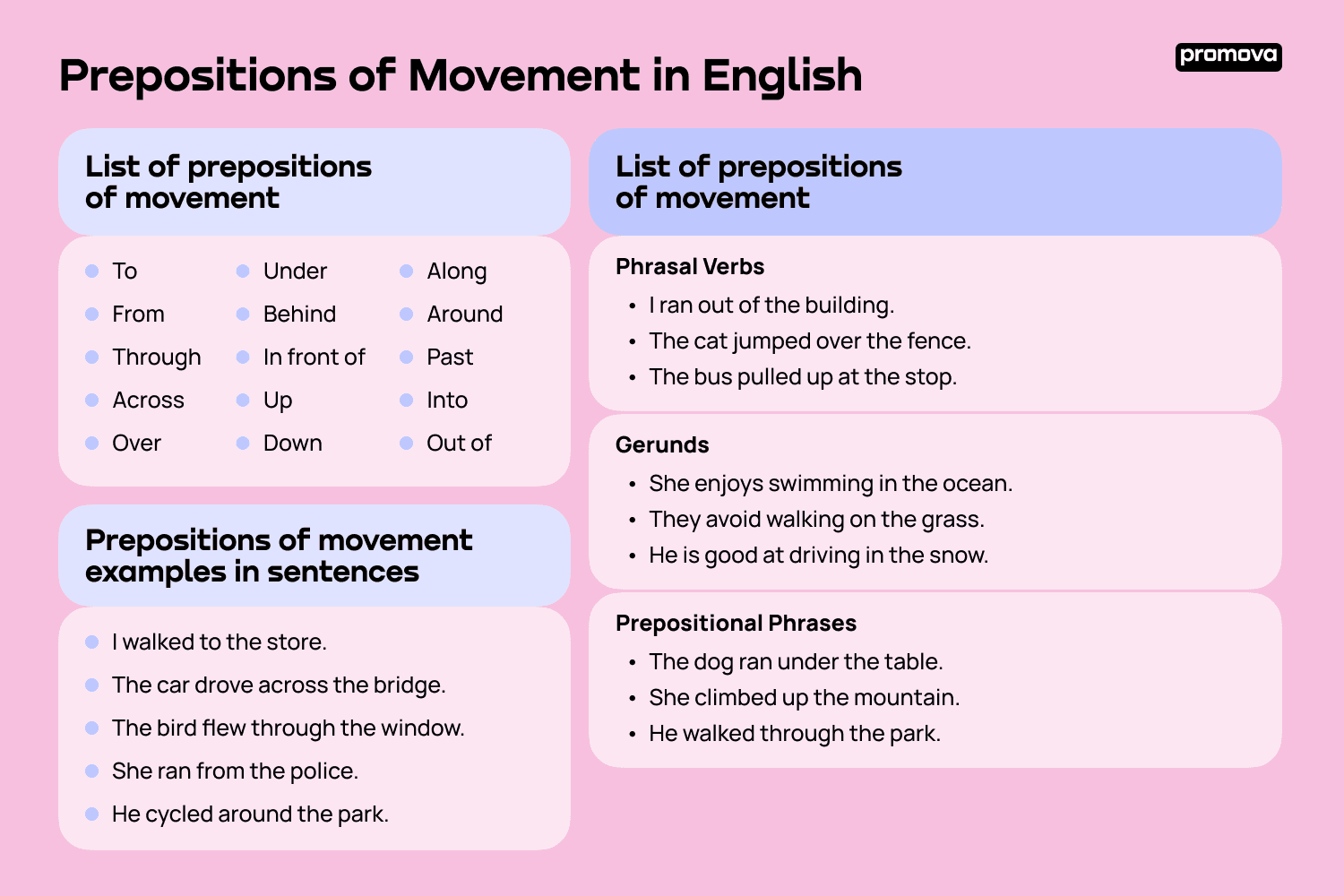Prepositions of Movement in English
Contents
Prepositions of movement are an important part of communication in English and they are essential in describing the direction and manner of movement for others to understand you. In this reference, we will guide you through what prepositions of movement are, provide examples of their use in sentences, explain their usage in grammar, and common mistakes to avoid.
What is a Preposition of Movement?
A preposition of movement is a word that describes the direction and manner of movement of a person or object. These prepositions are used to indicate where an object is moving from, where it is moving to, or how it is moving. Common examples of prepositions of movement include “to,” “from,” “through,” “across,” “over,” “under,” “behind,” and “in front of.”
Prepositions of movement differ from prepositions of place, which describe where something is located. For instance, “in,” “on,” and “at” are prepositions of place, while “to,” “from,” and “across” are prepositions of movement.

Prepositions of movement examples in sentences
Prepositions of movement are used in a wide range of scenarios, from describing the movement of vehicles to the movement of people. Here are some examples of prepositions of movement in sentences:
- I walked to the store.
- The car drove across the bridge.
- The bird flew through the window.
- She ran from the police.
- He cycled around the park.
These examples show how prepositions of movement are used to describe the direction and manner of movement in different contexts.
Using movement prepositions in grammar
Prepositions of movement are used in various ways in grammar, including in phrasal verbs, gerunds, and prepositional phrases.
Phrasal Verbs
Phrasal verbs consist of two or three words, with the first word being the verb, and the second word being a preposition or an adverb. Prepositions of movement are commonly used in phrasal verbs to describe the movement of the subject. For example:
- I ran out of the building.
- The cat jumped over the fence.
- The bus pulled up at the stop.
Gerunds
Gerunds are regular verbs that end in “-ing” and function as nouns in a sentence. Prepositions of movement are often used with gerunds to describe the movement of the subject. For example:
- She enjoys swimming in the ocean.
- They avoid walking on the grass.
- He is good at driving in the snow.
Prepositional Phrases
Prepositional phrases consist of a preposition and a noun or pronoun. Prepositions of movement are commonly used in prepositional phrases to describe the movement of the subject. For example:
- The dog ran under the table.
- She climbed up the mountain.
- He walked through the park.
2
List of prepositions of movement
Here is a list of prepositions of movement that are commonly used in English:
- To
- From
- Through
- Across
- Over
- Under
- Behind
- In front of
- Up
- Down
- Along
- Around
- Past
- Into
- Out of
This is not a full list, but it covers the most commonly used prepositions of movement in the English language.
Prepositions of movement in phrases
Prepositions of movement are often used in phrases to provide more context and detail to a sentence. Here are some examples of prepositions of movement used in phrases:
- She ran out of the room in a hurry.
- He drove his car into the garage.
- They walked along the beach at sunset.
- The ball rolled down the hill and into the river.
- She climbed up the stairs to the rooftop.
These phrases show how prepositions of movement can be used to describe the direction and manner of movement in more detail, making the sentence more descriptive and informative.
Common Mistakes
As with any aspect of language learning, there are common mistakes that learners make when using prepositions of movement.
- Using the wrong preposition: For example, using “into” instead of “in” or “on” instead of “at.”
- Forgetting to use a preposition: For example, saying “He ran the store” instead of “He ran to the store.”
- Using the wrong word order: For example, saying “She walked the street” instead of “She walked down the street.”
- Confusing prepositions of movement with prepositions of place: For example, saying “He walked to the park” instead of “He walked in the park.”
To avoid these mistakes, it is essential to practice using prepositions of movement in context and to pay attention to the usage of prepositions in native English speakers.
Summary
Prepositions of movement are an essential aspect of English grammar, and they are used to describe the direction and manner of movement of objects and people. They are commonly used in phrasal verbs, gerunds, and prepositional phrases, and they provide more detail and context to a sentence. With time, you will learn to avoid mistakes and master them all on your own!



Comments